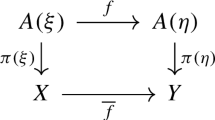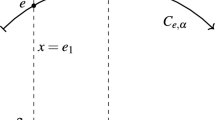Abstract
We present a framework which leverages the underlying topology of a data set, in order to produce appropriate coordinate representations. In particular, we show how to construct maps to real and complex projective spaces, given appropriate persistent cohomology classes. An initial map is obtained in two steps: First, the persistent cohomology of a sparse filtration is used to compute systems of transition functions for (real and complex) line bundles over neighborhoods of the data. Next, the transition functions are used to produce explicit classifying maps for the induced bundles. A framework for dimensionality reduction in projective space (Principal Projective Components) is also developed, aimed at decreasing the target dimension of the original map. Several examples are provided as well as theorems addressing choices in the construction.




















Similar content being viewed by others
Notes
Using a 7th nearest neighbor graph.
Determined experimentally using a persistent cohomology computation.
References
Bott, R., Tu, L.W.: Differential Forms in Algebraic Topology. Graduate Texts in Mathematics, vol. 82. Springer, New York (2013)
Carlsson, G.: Topology and data. Bull. Am. Math. Soc. 46(2), 255–308 (2009)
Carlsson, G.: Topological pattern recognition for point cloud data. Acta Numerica 23, 289–368 (2014)
Carlsson, G., Mémoli, F.: Characterization, stability and convergence of hierarchical clustering methods. J. Mach. Learn. Res. 11, 1425–1470 (2010)
Carlsson, G., Mémoli, F.: Classifying clustering schemes. Found. Comput. Math. 13(2), 221–252 (2013)
Cavanna, N.J., Jahanseir, M., Sheehy, D.R.: A geometric perspective on sparse filtrations (2015). arXiv:1506.03797
Chan, J.M., Carlsson, G., Rabadan, R.: Topology of viral evolution. Proc. Natl. Acad. Sci. USA 110(46), 18566–18571 (2013)
Chazal, F., Cohen-Steiner, D., Lieutier, A.: A sampling theorem for compact sets in Euclidean space. Discrete Comput. Geom. 41(3), 461–479 (2009)
Chen, C., Freedman, D.: Hardness results for homology localization. Discrete Comput. Geom. 45(3), 425–448 (2011)
Cohen-Steiner, D., Edelsbrunner, H., Harer, J.: Stability of persistence diagrams. Discrete Comput. Geom. 37(1), 103–120 (2007)
De Silva, V., Ghrist, R.: Coverage in sensor networks via persistent homology. Algebr. Geom. Topol. 7(1), 339–358 (2007)
De Silva, V., Morozov, D., Vejdemo-Johansson, M.: Dualities in persistent (co)homology. Inverse Probl. 27(12), Art. No. 124003 (2011)
De Silva, V., Morozov, D., Vejdemo-Johansson, M.: Persistent cohomology and circular coordinates. Discrete Comput. Geom. 45(4), 737–759 (2011)
De Silva, V., Skraba, P., Vejdemo-Johansson, M.: Topological analysis of recurrent systems. In: Workshop on Algebraic Topology and Machine Learning. NIPS (2012)
Dey, T.K., Hirani, A.N., Krishnamoorthy, B.: Optimal homologous cycles, total unimodularity, and linear programming. SIAM J. Comput. 40(4), 1026–1044 (2011)
Dey, T.K., Sun, J., Wang, Y.: Approximating loops in a shortest homology basis from point data. In: Proceedings of the 26th Annual Symposium on Computational Geometry (SCG’10), pp. 166–175. ACM, New York (2010)
Edelsbrunner, H., Jabłoński, G., Mrozek, M.: The persistent homology of a self-map. Found. Comput. Math. 15(5), 1213–1244 (2015)
Ghrist, R., Muhammad, A.: Coverage and hole-detection in sensor networks via homology. In: Proceedings of the 4th International Symposium on Information Processing in Sensor Networks (IPSN’05), p. 254–260. IEEE Press (2005)
Hatcher, A.: Algebraic Topology. Cambridge University Press, Cambridge (2002)
Hitchin, N.: Communications-What is... a gerbe? Notices Am. Math. Soc. 50(2), 218–219 (2003)
Jolliffe, I.T.: Principal Component Analysis. Springer Series in Statistics, 2nd edn. Springer, New York (2002)
Jung, S., Dryden, I.L., Marron, J.S.: Analysis of principal nested spheres. Biometrika 99(3), 551–568 (2012)
Kruskal, J.B.: Multidimensional scaling by optimizing goodness of fit to a nonmetric hypothesis. Psychometrika 29, 1–27 (1964)
Lim, L.H.: Hodge Laplacians on graphs (2015). arXiv:1507.05379
Martin, S., Thompson, A., Coutsias, E.A., Watson, J.P.: Topology of cyclo-octane energy landscape. J. Chem. Phys. 132(23), 234115 (2010)
May, J.P.: A Concise Course in Algebraic Topology. Chicago Lectures in Mathematics. University of Chicago Press, Chicago (1999)
Milnor, J.W., Stasheff, J.D.: Characteristic Classes. Annals of Mathematics Studies. Princeton University Press, Princeton (1974)
Miranda, R.: Algebraic Curves and Riemann Surfaces. Graduate Studies in Mathematics, vol. 5. American Mathematical Society, Providence (1995)
Morozov, D.: Dionysus (2012). http://mrzv.org/software/dionysus/
Niyogi, P., Smale, S., Weinberger, S.: Finding the homology of submanifolds with high confidence from random samples. Discrete Comput. Geom. 39(1–3), 419–441 (2008)
Perea, J.A.: Persistent homology of toroidal sliding window embeddings. In: 2016 IEEE International Conference on Acoustics, Speech and Signal Processing (ICASSP), pp. 6435–6439. IEEE (2016)
Perea, J.A., Carlsson, G.: A klein-bottle-based dictionary for texture representation. Int. J. Comput. Vis. 107(1), 75–97 (2014)
Perea, J.A., Harer, J.: Sliding windows and persistence: an application of topological methods to signal analysis. Found. Comput. Math. 15(3), 799–838 (2015)
Schönemann, P.H.: A generalized solution of the orthogonal procrustes problem. Psychometrika 31(1), 1–10 (1966)
Serre, J.-P.: Faisceaux algébriques cohérents. Ann. Math. 61, 197–278 (1955)
Tausz, A., Carlsson, G.: Homological coordinatization (2011). arXiv:1107.0511
Tenenbaum, J.B., De Silva, V., Langford, J.C.: A global geometric framework for nonlinear dimensionality reduction. Science 290(5500), 2319–2323 (2000)
Weinberger, S.: What is... persistent homology? Notices Am. Math. Soc. 58(1), 36–39 (2011)
Acknowledgements
The author would like to thank Nils Baas, Ulrich Bauer, John Harer, Dmitriy Morozov and Don Sheehy for extremely helpful conversations regarding the contents of this paper. The detailed comments of the anonymous reviewers were invaluable in fixing multiple imprecisions found in the original draft; thank you for the high-quality feedback. This work was partially supported by the NSF under Grant DMS-1622301 and DARPA under Grant HR0011-16-2-003.
Author information
Authors and Affiliations
Corresponding author
Additional information
Editor in Charge: Kenneth Clarkson
Rights and permissions
About this article
Cite this article
Perea, J.A. Multiscale Projective Coordinates via Persistent Cohomology of Sparse Filtrations. Discrete Comput Geom 59, 175–225 (2018). https://doi.org/10.1007/s00454-017-9927-2
Received:
Revised:
Accepted:
Published:
Issue Date:
DOI: https://doi.org/10.1007/s00454-017-9927-2




